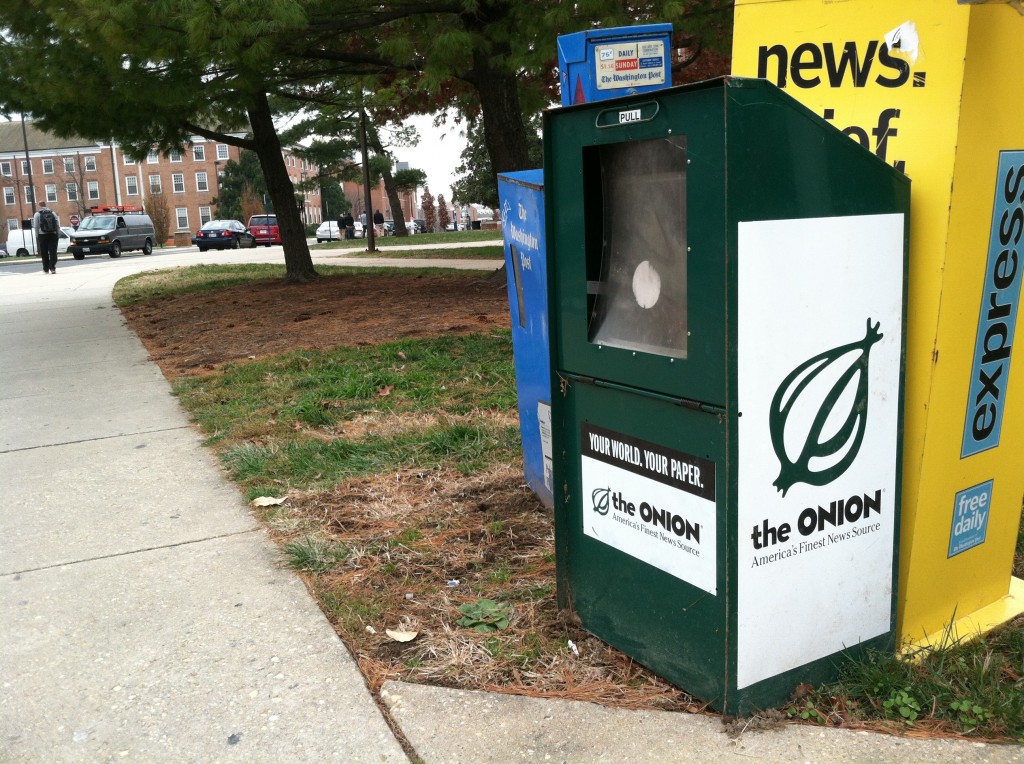
The Onion turned its satirical brand of humor on itself recently when it published a story under the headline “‘NCIS’ to Cease Print Edition'” just days after announcing The Onion was halting its own print operation.
The spoof story said, “our business model unfortunately can no longer support physical, hard-copy editions of the Naval Criminal Investigation Service’s adventures.”
The same could be said of The Onion, which will be ceasing its print edition with the Dec. 12 issue.
“We’ve known that the print edition may come to an end for a long time,” said Mike McAvoy, The Onion’s president.

The Onion ceases its print operation this month and goes to an online-only format. Credit: Lyle Kendrick
Writing on the Wall
McAvoy said The Onion saw a decline in nationwide print across the journalism industry in 2007, which made the company push toward a digital-first strategy.
“From there we never believed that print would have a resurgence,” he said. “Basically we planned for this long ago.”
The Onion began creating exclusively digital content in 2006 when it created The Onion News Network, the video arm of the outlet that launched in 2007.
In 2009, The Onion made the decision to franchise its print edition to partners.
After franchising the papers, The Onion’s partner company would provide the sales team and distribute and lay out the paper. The Onion would provide content to its partners for a fee.
“In the end it allowed us to focus on our digital business and let someone else worry about running the print business,” McAvoy said.
The Onion’s last three print partners were in Chicago, Providence, R.I. and Milwaukee.
While these franchises expanded the paper’s cash flow, the company reinvested the money it earned from print into digital growth.
But the company wanted to focus solely on its digital product.
In the end, McAvoy said it was more important for The Onion to be creating strong content than to worry about keeping a print edition alive.
“I’m so thankful that when we saw the writing on the wall, we acted,” McAvoy said.
Related story: “5 Lessons News Outlets Can Take from The Onion”
Even before The Onion announced the close of its print edition, some of its stories acknowledged the challenges of maintaining a print operation.
Earlier this year, the paper ran a story under the headline “Print Dead at 1,803″ eulogizing print as a means of communication.
The Onion now has 10 million unique visitors a month to its main website and 4 million a month to the A.V. Club, its non-satirical pop culture page, he said. Nearly half of its traffic is mobile and 70 to 75 percent of all traffic comes from social media.
Digital Strategy Moving Forward
As The Onion transitions to a fully digital approach, its advertising strategy is changing.
McAvoy said The Onion’s main revenue source from digital was previously based around display and banner ads, but now the majority of the ad campaigns the company uses revolve around custom content for advertising, such as branded content and native advertising.
The Onion now has a creative services arm called Onion Labs which focuses on creating content for advertisers.
Matt McDonagh, vice president of national sales at The Onion, said Onion Labs took off about two and a half years ago with its work helping Microsoft rebrand Internet Explorer as the “browser you loved to hate.”
The Onion helped Microsoft create content for a Tumblr website which focuses on how much stronger new versions of Internet Explorer are than older ones.
The ad project led to formalizing the Onion Labs as a creative arm for the company.
Now about 90 percent of the company’s digital revenue comes from the custom elements that Onion Labs helps produce.
“Onion Labs has really become our business,” McDonagh said.
McDonagh said the biggest project Onion Labs is working on is the web series “Tough Season,” which is sponsored by Lenovo and follows the plight of “Brad,” a fantasy football enthusiast vying to win his league.
The web series also features NFL players, such as Larry Fitzgerald and Alfred Morris.
Lenovo began working with The Onion because it was attracted to how passionate the company’s consumer base is, said Kevin Berman, the director of North American advertising and marketing services for Lenovo.
“We felt that there was no one better than The Onion to help us reach a millennial audience,” he said.
McDonagh said Lenovo and the global marketing agency DigitasLBi were partners in helping build the project, but the clients recognized the abilities of The Onion writers.
Some of the ways Lenovo is used in the series is “Brad” using a Lenovo computer, characters mispronouncing the company’s name and press conferences using a Lenovo backdrop.
Lenovo, which is in a marketing partnership with the NFL, wanted to leverage that partnership with a humorous bent, Berman said.
The Onion plans to continue forging business relationships like the one with Lenovo.
McAvoy said The Onion will be launching a few partnerships in 2014. Many of the current advertising campaigns are short-term projects, but the company is working on creating multi-year campaigns, he said.
“We’ll work with brands in the same way that we develop our own brand,” McDonagh said.
The Onion’s Audience
McDonagh said Onion Labs applies the same approach to creating branded content that the company applies to The Onion itself.
McAvoy said The Onion’s main reader demographic is between 18 and 34 years old and smart. He said while it doesn’t have direct competition with another outlet, it gets a similar audience as The Economist, The New York Times and other websites that well informed readers visit.
The Onion describes that readership another way.
In the franchising section of its website, there is a note from a fictional character named H. Cuthbert Zweibel that describes the readership.
It reads: “The typical Onion reader tends to be an almost insufferably literate and unbearably thoughtful type, the sort of person whose emotional shortcomings render them unable to face the world without filtering it through a veil of sarcasm.”
The Onion’s readers seem to have responded well to the company becoming exclusively digital.
McAvoy said there has not been major backlash.
“In the end, people understand [that making] a print edition profitable has become increasingly difficult,” McAvoy said.








Leave a Comment